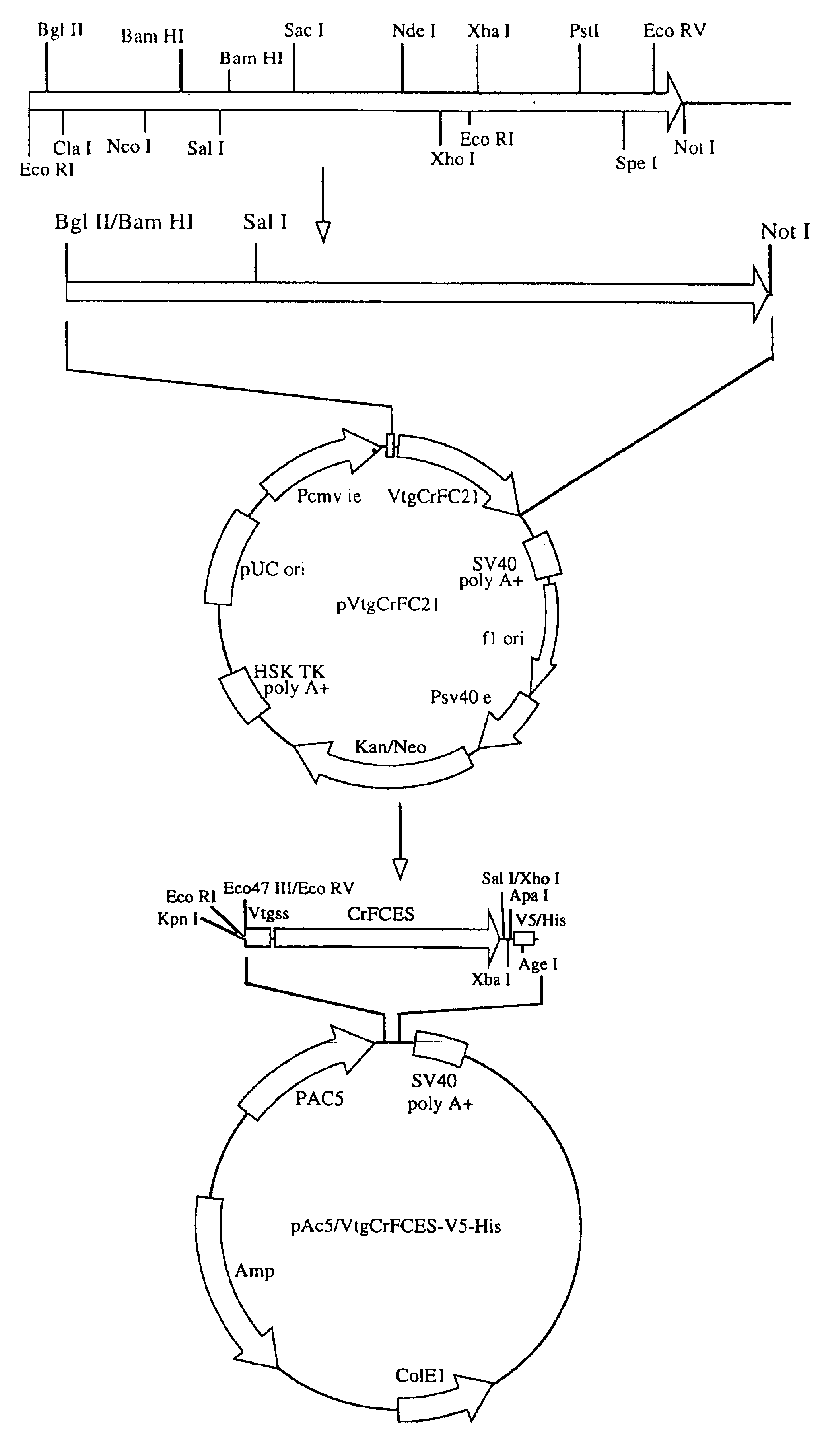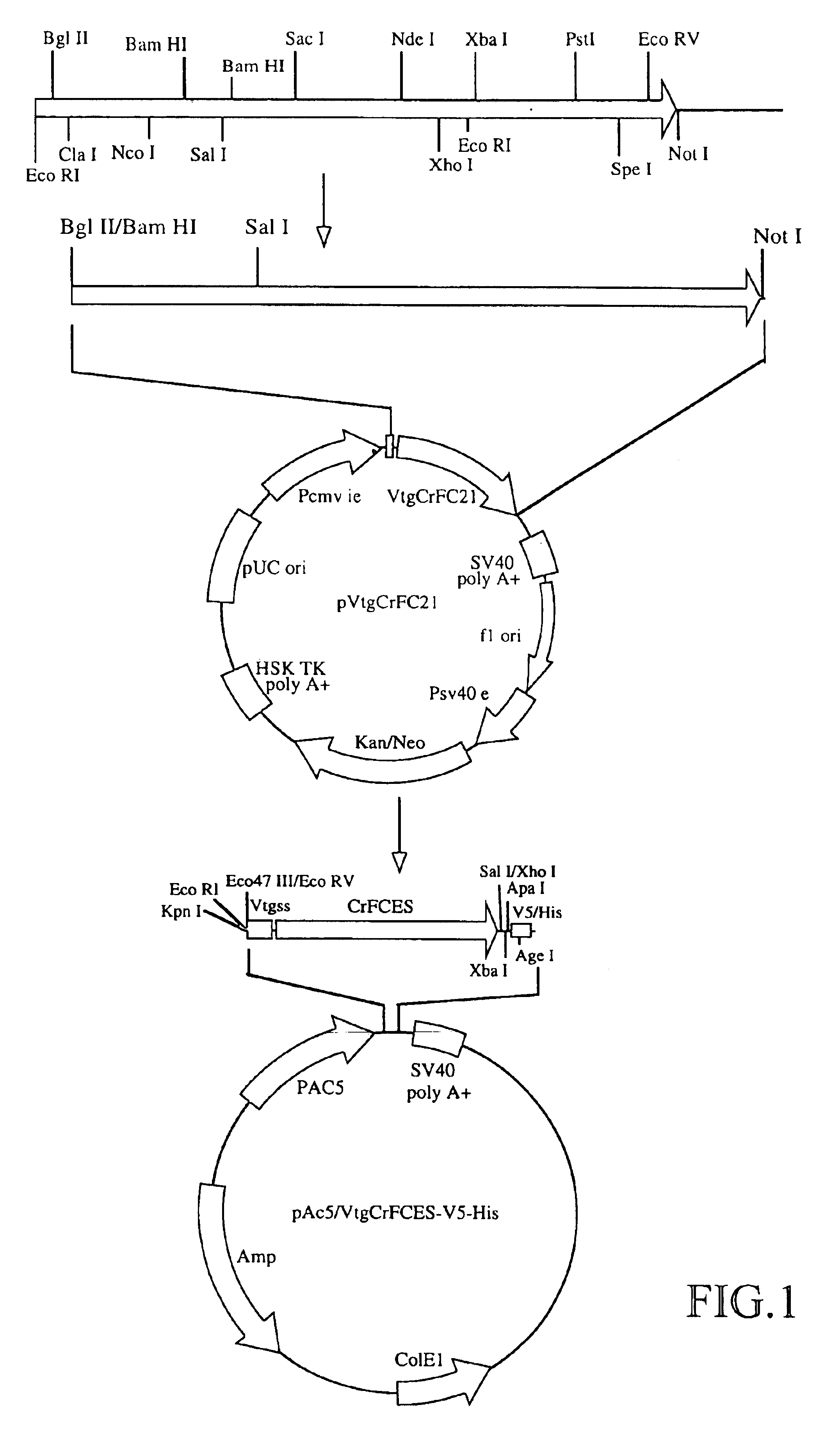Isolated nucleic acids encoding a secretory signal for expression and secretion of heterologous recombinant proteins
a technology of heterologous recombinant proteins and secretory signals, which is applied in the direction of dna/rna fragmentation, peptides, and fused cells, etc., can solve the problems of difficult engineering the secretion of large amounts of expressed proteins in e. coli, difficult to validate proteins for pharmaceutical/diagnostic use, and often not properly folded eukaryotic proteins expressed in e. coli. , to achieve the effect of easy
- Summary
- Abstract
- Description
- Claims
- Application Information
AI Technical Summary
Benefits of technology
Problems solved by technology
Method used
Image
Examples
example 2
Inducible Expression and Secretion of the Recombinant VtgssCAT and VtgssEGFP Reporters From Mammalian Cells
We have thus constructed-a reporter CAT system (FIGS. 5A-5G) that uses the secretory signal of the O. aureus vitellogenin gene (Vtgss). The excellent secretory signal provides quantitative secretion of the CAT reporter protein into the culture medium, and thus it is not necessary to prepare a cell lysate to assay for the reporter protein. An investigator is thus provided with an easy assay for CAT activity and so can retain methodology that he / she has previously established in the laboratory. This permits easy comparison with data previously obtained using a CAT reporter protein.
The psp-VtgCAT (FIGS. 5D and 5E) and ERU-psp-VtgCAT (FIG. 5F) vectors were constructed by typical methods. The psp-VtgCAT has the pSEAP-Promoter vector backbone, but the SEAP gene is replaced by the recombinant VtgCAT gene. The ERU-psp-VtgCAT is psp-VtgCAT with the estrogen response unit from a Xenopus ...
example 3
Inducible Expression and Secretion of Recombinant CAT Reporter From Other Mammalian Cells (NIH / 3T3 and CHO-B)
Estrogen-inducibility of ERU-psp-VtgssCAT was also demonstrated in other mammalian cell lines. NIH / 3T3 (normal mouse fibroblast cells) and CHO-B (Chinese hamster ovary cells) were transfected as described in Example 3. Three time points were assayed for VtgssCAT secretion into the culture medium, 0, 6 and 24 h post estrogen induction. Peak expression of VtgssCAT was at 24 h. NIH / 3T3 and CHO-B cells exhibited a 4-fold and 5.5-fold increase in VtgssCAT (FIG. 9). The results show that the estrogen-responsiveness, production and secretion of VtgssCAT is not limited to COS-1 cells.
example 4
Inducible Expression and Secretion of Recombinant CAT Reporter From Piscine Cells
Co-transfection of the ERU-psp-VtgCAT construct with chicken estrogen receptor cDNA into a piscine cell line (e.g., Carp Epithelial cells, EPC) also resulted in estrogen-inducible expression and secretion of the CAT reporter protein into the culture medium (FIG. 10). EPC were cultured at a low temperature of 25.degree. C. A 3-fold increase in VtgCAT can be detected by 24 h after estrogen-induction. The low metabolic rate of EPC likely explains the lower induction of VtgCAT compared to the levels observed in Example 3. Nonetheless, this experiment shows the efficiency of production and secretion of VtgCAT conferred by Vtgss. Furthermore, the Vtgss-directed secretion process is applicable to all eukaryotic cells; it is not limited to mammalian cells.
PUM
| Property | Measurement | Unit |
|---|---|---|
| Biological properties | aaaaa | aaaaa |
| Hydrophobicity | aaaaa | aaaaa |
Abstract
Description
Claims
Application Information
 Login to View More
Login to View More - R&D
- Intellectual Property
- Life Sciences
- Materials
- Tech Scout
- Unparalleled Data Quality
- Higher Quality Content
- 60% Fewer Hallucinations
Browse by: Latest US Patents, China's latest patents, Technical Efficacy Thesaurus, Application Domain, Technology Topic, Popular Technical Reports.
© 2025 PatSnap. All rights reserved.Legal|Privacy policy|Modern Slavery Act Transparency Statement|Sitemap|About US| Contact US: help@patsnap.com



